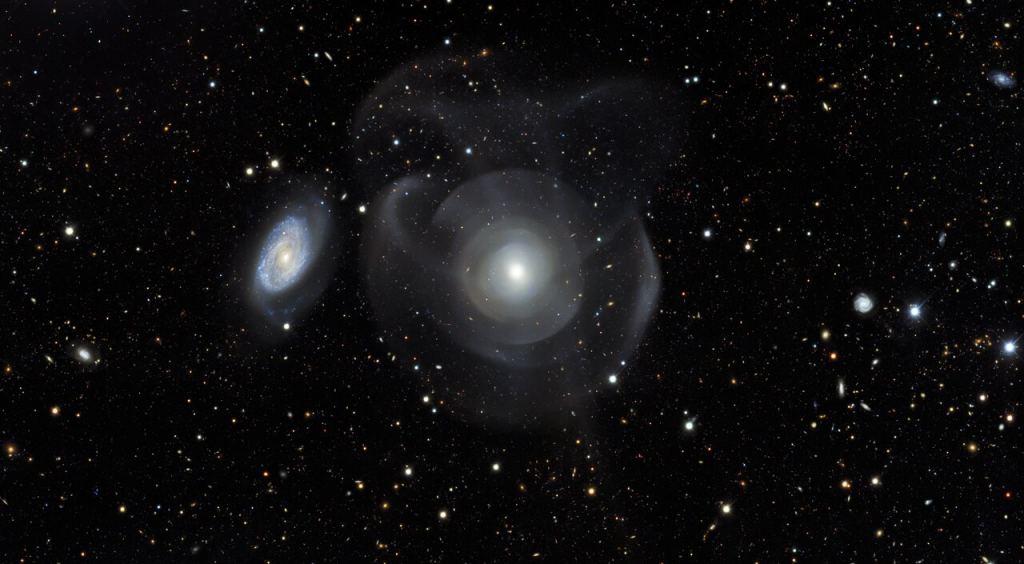A New Survey of the Sky Contains Over One Billion Galaxies
By Carolyn Collins Petersen
What contains a petabyte of data on more than a billion galaxies in one of the most extensive sky maps? The answer: the ever-expanding Dark Energy Spectroscopic Instrument (DESI) Legacy Imaging Survey. The galaxies it charts are part of the largest two-dimensional map of the sky ever made. And, just recently, it grew even larger with the addition of new data from telescopes in the U.S. and Chile.
The DESI Legacy Imaging Survey builds on data included in two earlier companion surveys: the Dark Energy Camera (DECam) Legacy Survey and the Beijing-Arizona Sky Survey. Jointly these efforts imaged 14,000 square degrees of the sky visible from the northern hemisphere. The data came from telescopes at NSF’s NOIRLab’s Kitt Peak National Observatory and Cerro Tololo Inter-American Observatory in Chile.
With the addition of southern sky images, the Legacy Surveys now cover over 20,000 square degrees. That’s nearly half the sky mapped in incredible detail in both optical and near-infrared wavelengths.
Charting the Universe’s Galaxies
When the landmark Hubble Deep Field image was released in 1993, astronomers realized that the Universe is filled with galaxies. It was, as some astronomers pointed out, the discovery of galaxies as far as we can detect. The nearby ones are relatively easy to observe. However, the true value of the deep field observations was the discovery of millions and millions of distant, dim ones. They appeared as little more than faint smudges of light. Many of those galaxies appear as they were in the earliest epochs of the Universe’s history. They can tell us a great deal about conditions a few hundred million years after the Big Bang. But, there are other lessons to learn from the panoply of galaxies in the Universe.
When you put together all the deep field images and surveys of distant galaxies, you start to see a grand cosmic structure emerging. By creating comprehensive maps of even the dimmest and most-distant galaxies, astronomers are better able to study that structure. Furthermore, the immense amounts of data allow them to start unraveling the properties and distribution of dark matter. Finally, because surveys allow scientists to chart the expansion of the Universe, such maps also give them a chance to zero in on the properties of the still-mysterious dark energy.

How the Galaxies Survey Assists Astronomers
The latest additions to the Legacy survey expand what astronomers see and give them new tools for understanding the Universe. “The addition of near-infrared wavelength data to the Legacy Survey will allow us to better calculate the redshifts of distant galaxies, or the amount of time it took light from those galaxies to reach Earth,” said Alfredo Zenteno, an astronomer with NSF’s NOIRLab and principal investigator of a deep field survey called DECam eROSITA Survey (DeROSITAS).
For example, the galaxy cluster Abell 3158 (above) is an interesting part of these data sets. It’s bright and large and lies about 825 million light-years away from us. Astronomers study cluster dynamics using these collections of galaxies. They also want to know more about the metallicity of the stars in the outer galaxies of the cluster. Understanding the distribution of metals (elements heavier than hydrogen and helium) in those galaxies gives astronomers a better handle on the total mass of metals in the Universe. It also provides clues to star formation in the early epochs of cosmic history. Redshift information on both close-by and distant galaxies is necessary to provide more accurate measurements of metallicity, according to Zenteno.
“This is essential for surveys at radio and x-ray wavelengths that need the complete ‘optical’ view to identify the origin of the emission, like clusters of galaxies and active supermassive black holes,” said Mara Salvato, a researcher at the Max Planck Institute for Extraterrestrial Physics (MPE) and spokesperson for eROSITA.
Why Go Deeper?
Another important reason for expanding this sky map is to identify roughly 40 million target galaxies for the five-year DESI Spectroscopic Survey. That dark energy survey focuses on the search for understanding dark energy by precisely mapping the expansion history of the Universe over the last 12 billion years. The DESI project has now selected its targets and the spectroscopic survey is currently underway.
Scientists in several disciplines have an interest in the dark matter problem. But there are many others who benefit from the growing archive of astronomical data coming out of the Legacy Surveys. The publicly available data make it possible for astronomy enthusiasts and curious individuals to digitally peruse the Universe around us.
“Anyone can use the survey data to explore the sky and make discoveries,” said Arjun Dey, an astronomer with NSF’s NOIRLab. “In my opinion, it is this ease of access that has made this survey so impactful. We hope that in a few years, the Legacy Surveys will have the most complete map of the entire sky, and provide a treasure trove for scientists well into the future.”
For More Information
Over One Billion Galaxies Blaze Bright in Colossal Map of the Sky
X-ray studies of the Abell 3158 galaxy cluster with eROSITA
The post A New Survey of the Sky Contains Over One Billion Galaxies appeared first on Universe Today.

February 26, 2023 at 04:14AM
via Universe Today read more...

Post a Comment